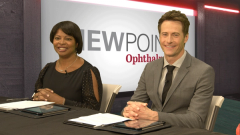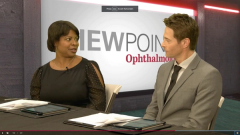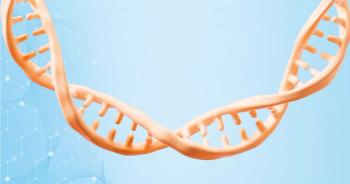
Managing Concurrent Neovascular AMD and Geographic Atrophy (GA)
Expert retina specialists discuss recent developments in the treatment landscape for geographic atrophy (GA) and the future management of patients with coexisting neovascular AMD and GA.
Episodes in this series

Nathan Steinle, MD: Another interesting topic we could talk about is dry age-related macular degeneration [AMD]. I used to think when I went to the conferences, they always put the worst topics at the very end, right? It used to be pediatrics, and then it’d be uveitis. At the very end, it would be dry AMD. And now dry AMD has moved to the front. It’s one of the very hot topics we’re talking about now. Just as of last month, we have an FDA-approved agent for dry AMD. Have you made the transition to treating dry AMD? Tell me your thoughts.
Adrienne Scott, MD: Again, very fascinating. These are groups of patients who never had any therapies. We’ve been speaking about patients with wet AMD who are now getting excellent vision outcomes, more so than before these agents were available. And the GA [geographic atrophy] folks were left behind. So, to me, it’s exciting to be able to at least tell the patients there are developments, and I think our patients get encouraged when they know that there may be treatments for their disease, which we said there’s no treatment for and told them to take these arid supplements but without any hopes of really impacting their disease.
So, I haven’t used these GA therapies as of yet. At my institution, Johns Hopkins University in Baltimore, Maryland, it usually takes a while to get new medications in our hands. But that works to our advantage sometimes, since we are waiting, watching to see what’s going on in the real world. I’ve been speaking about it with patients and trying to assess their excitement for the drugs. And there’s been quite a mixed response. You have some people who are quite enthusiastic and can’t wait to use it, and then you have some patients who say, “Well, is it going to make my vision better?” And I have to answer, “No it hasn’t been shown to do that.” And that decreases their excitement quite a bit.
Nathan Steinle, MD: How about over here? For pegcetacoplan, what are your thoughts?
Prethy Rao, MD, MPH: I’m very excited about the medication, in terms like Dr Scott said. Historically, we’ve had not much treatment except the arid supplement. Now we’re giving patients hope that there is treatment for dry AMD in terms of slowing the process. I am having discussions with patients about it being an option. I think in terms of implementation, it’s harder to convince patients, like Dr Scott was saying. Your vision is not getting better.
The beauty of anti-VEGF [anti–vascular endothelial growth factor] treatment for neovascular AMD is that their vision gets better. They have that motivation to maintain their vision. But in the patients who are seeing fairly well, it’s hard to convince them to get an injection in their eye. And the hard part is that we don’t know for how long the treatment lasts. We have clinical trials that say up to 2 years, but after that, what happens? Do we still do it? How often do we do it? Do we shift to more of a treat-and-extend regimen, where we’re doing it every 4 or 5 months? So, it’s hard to talk about that with patients.
Nathan Steinle, MD: For sure, yes. There’s a 3-year GALE extension trial going on, so we’ll have 5-year data at some point, but yes, it’s down the road for sure. Dr Regillo, what are your thoughts?
Carl Regillo, MD, FACS, FASRS: When we talk about AMD as a whole, when we say dry [AMD], we’re talking about the advanced dry form, right? Geographic atrophy is the form that will typically cause some degree of symptoms and visual acuity loss. For most of our patients, they have early/intermediate dry AMD, and many of them will never convert to wet AMD. Many of them will never get GA. But with our patients living longer, they’ll either convert to wet AMD and get GA later or just simply get GA later if they grow old enough to get it or depending on the characteristics of their disease. So as everyone’s saying, we haven’t had an effective treatment for GA to alter the natural history of this slowly but relentlessly progressing condition.
I’m very excited that for the first time, we have a drug that can, to a small degree, slow the rate of growth of geographic atrophy. It’s logical to treat early if we can, before the GA affects vision or knocks visual acuity down. But even in patients who have lost some vision, it still could be beneficial to slow the rate of growth of GA. We have the one approved agent, pegcetacoplan, which is a complement inhibitor that blocks C3 synthetic peptides that were injected intravitreally. And based on the results of the clinical study, we talked about the frequency of injections. It’s going to be a fixed regimen. There’s no way to monitor the response to therapy. You can only hope that the patient’s going to behave on average as they did in the studies, with a slight reduction in the rate of growth, and monitor them for adverse events, which I’m sure you’ll get into.
But it has some downsides. I’ve already started to treat patients with this drug, and for the most part, I’m telling them it’s going to be every month or 2. And most seem to prefer 2 months, knowing that every 2 months worked almost as well as every month, but with half the adverse events. So, phrasing it that way, most end up choosing every 2 months. I think that’s how I’m going to utilize the drug for the most part. I’m sure there’ll be exceptions.
Nathan Steinle, MD: Talk to me a little about the safety profile for pegcetacoplan and what concerns you have.
Prethy Rao, MD, MPH: I think the IOI [idiopathic orbital inflammatory] events are a significant concern. I think it was around 2% or 3% in the clinical trial. We’ll see how that plays out in the real world. It is still promising, so I still think it’s something we should offer patients, with the caveat that we might have that safety signal as well. So, we’ll see just over time.
Nathan Steinle, MD: And how about this conversion from dry to wet AMD? What do you think the mechanism is, and what are your thoughts?
Carl Regillo, MD, FACS, FASRS: Well, I can tell you we don’t know the mechanism. But it’s not unique to blocking C3. It looks like it’s also a phenomenon that occurs with blocking C5, which is the other agent, avacincaptad, that has the potential to get FDA approved later this year because it had successful registration studies reducing the rate of GA growth. It had a similar efficacy and similar safety profile. But it is an issue, and every patient needs to know that if you have dry AMD with GA, which is the patient population we’re talking about treating, the risk of turning wet AMD based on these pivotal studies with these 2 drugs, is in the range of about 3% to 4% per year. And that’s going to increase by blocking complement, at least C3, C5. They need to know that if they’re starting on a course of therapy for their GA, they have to accept the trade-off that they may have a higher rate of conversion to corneal vascularization and the potential to get dual treatments, one for each condition. Or they may elect to stop the GA treatment, knowing that the wet AMD is the bigger, more acute threat to the vision.
But nonetheless in the clinical trials at the phase 3 level, we were allowed to treat wet AMD as we typically would in practice and continue to treat GA. And patients, in general, did quite well who converted. So, in practice, I anticipate that in the very near future, I’ll be doing dual therapy with 2 injections in these patients. And I’ve had a good reception to the notion of doing treatments in patients with GA, a select group that either have their vision imminently threatened or are already starting to be affected by GA. They’re willing and able to undergo a course of regular, frequent treatments.
Prethy Rao, MD, MPH: Do you think the role of having this subretinal fluid phenomenon and having a complete drying effect and contributing to the GA will affect how you treat their neovascular component? Are you OK with tolerating a little bit more fluid in those patients?
Carl Regillo, MD, FACS, FASRS: Well, the one thing I will say is I’m not going to treat just CNV [choroidal neovascularization]. I’m going to treat actual exuding CNV. And even in practice without GA, I don’t treat CNV unless it’s actually leaking, it’s active, and therefore showing clinical manifestations of exudation. So, I’ll do the same here. If they’re starting to exude, I’ll treat them with anti-VEGF in hopes of maintaining the best possible vision outcome.
Adrienne Scott, MD: Dr Steinle, I’m interested in your thoughts.
Prethy Rao, MD, MPH: I know, exactly.
Adrienne Scott, MD: How do you feel about the geographic atrophy therapies?
Nathan Steinle, MD: Good question. I’ve been an early adopter in this one, so I have a number of patients who now are on treatment for dry AMDs. And the reception in my clinics has been phenomenal, honestly. It’s been an easy approach for patients, and they’re desperate for therapy. And my regimen so far, because on-label it’s approved for acute 25 to 60 days, is 1 to 2 months. And I’ve been splitting the difference at 6 weeks and just going right down the middle. Based on most of my feedback from patients, they can tolerate about every 6 weeks, and that seems to be well tolerated so far.
My concerns are 2-fold, one of which is a conversion from dry to wet AMD. And the second we don’t talk about a lot is the volume. It’s a 100-μl dosing, and so to do that so frequently in these patients over and over again, it’s a viscous substance. And so, you’re injecting it in the order of injecting syrup. It’s really thick. In the trials, we’ll have to watch in the real world how those frequent injections over time with 100 μl play out. And then to Dr Regillo’s point that if the patients did convert to wet AMD, they were treated the same day of first anti-VEGF-A and then getting the pegcetacoplan. So that’s 150 μl put in the eye in a single visit. That’s a lot of volume, so those are my concerns. But there are patients definitely willing to go through it, for sure.
Carl Regillo, MD, FACS, FASRS: It’s interesting because this age group, they’re older and it’s very rare for them not to know somebody who is getting an injection in their eye and knowing that it’s relatively well tolerated. I get very little pushback when I say, “Oh, by the way, there’s a treatment. This is what it could accomplish. This is the risk, and it’s an injection in the eye.” And I have yet to get, “I don’t want that.”
Nathan Steinle, MD: No.
Carl Regillo, MD, FACS, FASRS: Yet. It could happen.
Nathan Steinle, MD: You’re absolutely right. I think a big hurdle in the past is that patients just didn’t know the concept of getting an injection in the eye. And now I think in the older population, they have a lot of friends who are going through some of the therapies. Very true. One question for you really quick before we wrap up here. If you have a patient who has wet AMD now and you’re treating them and you’re starting to see a little area of GA off to the side, those are the tricky ones. What are your thoughts? Would you start applying pegcetacoplan to those patients in addition to anti-VEGF?
Adrienne Scott, MD: Yes. Still, my mind goes to the most rapidly growing, the process that’s most likely to be most detrimental to vision most quickly. So, my priority is going to be treating choroidal neovascularization. That said, I don’t have the GA treatments in my hands yet. But I’m thinking about when I do, this is exactly the type of person who may end up with both injections, or I will at least discuss the option with them.
Nathan Steinle, MD: Excellent. Any thoughts over here?
Carl Regillo, MD, FACS, FASRS: It’s inevitable. The day is coming that we’ll treat GA that converts to wet AMD. That’s a given, as we discussed. But wet AMD eventually gets GA, and we all have these patients. Their wet AMD is under phenomenal control. They’ve had great vision, but now their vision is being threatened or affected by the GA. They’re telling us that, and I think they’re going to want treatment.
Transcript edited for clarity
Newsletter
Keep your retina practice on the forefront—subscribe for expert analysis and emerging trends in retinal disease management.



















































